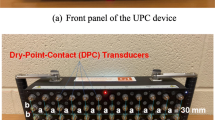Abstract
A direct and early-stage nondestructive quality inspection method for concrete in structures is proposed. The advantage of the proposed method is that it can apply ultrasonic pulse velocity and rebound hardness measurements at ages of their highest sensitivities, 24 hours and 3 days after mixing, and can predict the 28-day compressive strength in a satisfactory accuracy.
The proposed method involves the combined method of pulse velocity and rebound hardness that can provide versatile information other than strength and possibly predict durability related properties such as tensile strength, dynamic modulus of elasticity, density and water absorption.
Similar content being viewed by others
References
Nozaki Y, Shoshiroda T (1984) Evaluation of quality of concrete in structures. Proc. 2nd Int. Conf. In Situ / Nondestructive Testing of Concrete, Ottawa, 1–15.
Soshiroda T (1998) Ultrasonic pulse velocity as an indicator of concrete quality. Proc. 2nd Int. Conf. on Concrete Under Severe Environment, Tromsø, Norway, 3:2093–2102.
Soshiroda T, Voraputhaporn K (1998) Optimum testing age for nondestructive evaluation of concrete quality-approach to earlier inspection. Proc. Int. Expertcentrum Conf., Kosice, Slovakia, 42–47.
Soshiroda T, Voraputhaporn K (1999) Recommended method for earlier inspection of concrete quality by nondestrcutive testing. Proc. Int. Conf. Concrete Durability and Repair Technology, Dundee, 259–264.
Elvery RH, Ibrahim LAM (1976) Ultrasonic assessment of concrete strength at early ages. Mag. Concr. Res., 28(97): 181–190.
Katsuhata K, Soshiroda T (1993) Factors affecting the ultrasonic velocity in concrete–-Aggregate content and surface roughness. Prep. Annual Meeting AIJ, 253–254 (in Japanese).
Katsuhata K, Soshiroda T, Nishizawa H (1994) Factors affecting the ultrasonic velocity in concrete–-Aggregate and its particle size distribution. Prep. Annual Meeting AIJ, 843–844 (in Japanese).
Sakatsume K, Soshiroda T, Katsuhata K (1995) Factors affecting the ultrasonic velocity in concrete–-Ages and drying conditions. Prep. Annual Meeting AIJ, 1047–1048 (in Japanese).
Kakuta S, Kojima T (1991) Evaluation of very early age concrete using a wave propagation method. Proceeding 14 RILEM symposium on quality control of concrete structures, 167.
Ye G, van Breugel K, Fraaij ALA (2003) Experimental study and numerical simulation on the formation of microstructure in cementitious materials at early age. Cement and Concrete Research, 33:233–239.
Subramaniam KV, Mohsen JP, Shaw CK, Shah SP (2002) Ultrasonic technique for monitoring concrete strength gain at early age. ACI Materials Journal, 99(46):458–462.
Carette GG, Malhotra VM (1982) In situ tests: Variability and strength prediction of concrete at early ages. In Situ/Non destructive testing of concrete, ACI SP 82-7, 111–141.
Voraputhaporn K (2000) Study on inspection methods for quality of concrete in structures by nondestructive testing. Doctorate Thesis, Shibaura Institute of Technology, p. 66 (in Japanese).
RILEM: Recommendation of in Situ concrete strength determination by combined nondestructive method. NDT4-1993, RILEM Technical Recommendations for the Testing and Use of Construction Materials.
Pascale G, di Leo A, Bonora V (2003) Nondestructive assessment of the actual compressive strength of high-strength concrete. J. Mater. Civ. Eng., 15(5):452–459.
Facaoarru I, Dumitrescu I, Constanesca (1966) Concrete strength determination by nondestructive combined methods. RILEM Report, Achen, p. 41.
Samarin A (1991) Combined method. In Malhotra, V. M. and Carino, N. J. eds CRC Handbook on Nondestructive Testing of Concrete, CRC Press, 189–201.
Author information
Authors and Affiliations
Rights and permissions
About this article
Cite this article
Soshiroda, T., Voraputhaporn, K. & Nozaki, Y. Early-stage inspection of concrete quality in structures by combined nondestructive method. Mater Struct 39, 149–160 (2006). https://doi.org/10.1617/s11527-005-9007-6
Received:
Accepted:
Published:
Issue Date:
DOI: https://doi.org/10.1617/s11527-005-9007-6




